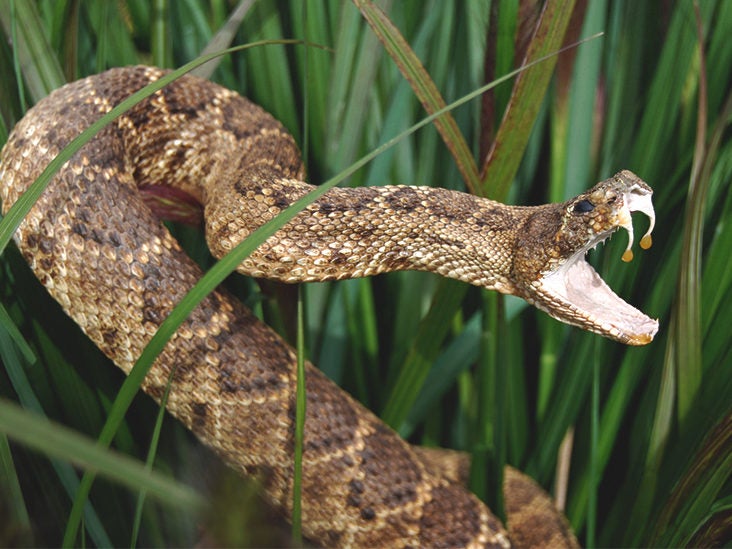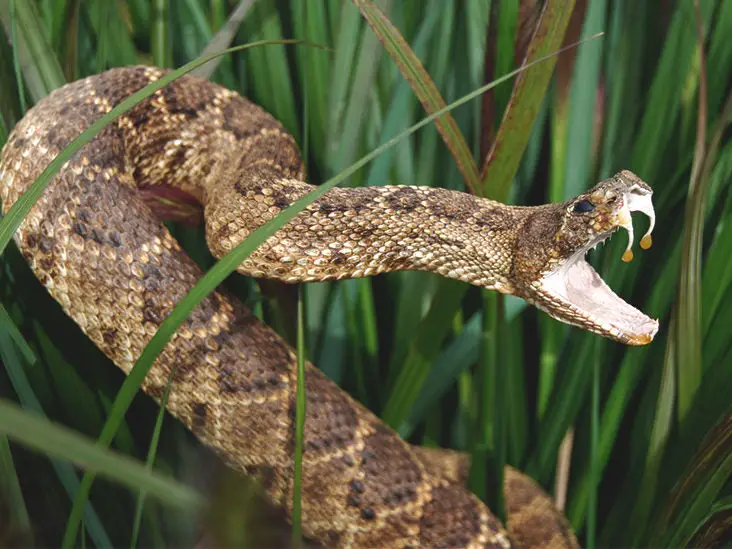Timber rattlesnakes are a venomous species of snake found in the eastern United States. While their distinctive rattle is often a warning to stay away, many people wonder just how dangerous a bite from one of these snakes can be. In this article, we will explore the effects of a timber rattlesnake bite and answer the question: is a timber rattlesnake bite deadly?
Snakebite incidents are not uncommon in the United States, with around 7,000 to 8,000 people bitten by venomous snakes each year. While some snakebites can be relatively harmless, others can be life-threatening. Understanding the risks and effects of a timber rattlesnake bite is crucial for anyone who spends time in areas where these snakes are found.
Yes, a timber rattlesnake bite can be deadly if left untreated. The venom of the timber rattlesnake can cause tissue damage, blood clotting issues, and affect the nervous system. It is important to seek medical attention immediately if bitten by a timber rattlesnake.

Is a Timber Rattlesnake Bite Deadly?
Timber rattlesnakes are venomous snakes that are found in the eastern part of the United States. They are known for their distinctive rattling sound, which is produced by their tail. While rattlesnakes are generally not aggressive, they will bite if they feel threatened. The question is, can a timber rattlesnake bite be deadly? Let’s find out.
Understanding Timber Rattlesnake Venom
Timber rattlesnake venom is a complex mixture of proteins and enzymes that can cause a wide range of symptoms. The venom contains both hemotoxic and neurotoxic components, which can affect the victim in different ways.
Hemotoxic venom affects the blood vessels and can cause swelling, pain, and tissue damage. Neurotoxic venom affects the nervous system and can cause paralysis, respiratory distress, and other symptoms.
The severity of the symptoms depends on the amount of venom injected, the location of the bite, and the health of the victim. In some cases, a timber rattlesnake bite can be fatal, especially if medical treatment is not sought immediately.
Symptoms of a Timber Rattlesnake Bite
The symptoms of a timber rattlesnake bite can vary depending on the amount of venom injected and the location of the bite. Common symptoms include:
– Severe pain at the site of the bite
– Swelling and redness
– Nausea and vomiting
– Dizziness and weakness
– Difficulty breathing
– Rapid heartbeat
– Blurred vision
– Numbness or tingling in the face, hands, or feet
These symptoms can appear within minutes or hours after the bite and can last for several days. In severe cases, the symptoms can progress to respiratory failure, cardiac arrest, and death.
Treatment for a Timber Rattlesnake Bite
If you are bitten by a timber rattlesnake, it is important to seek medical attention immediately. The first step in treatment is to immobilize the affected limb and keep it at or below heart level. This can help slow the spread of the venom.
Antivenom is the most effective treatment for a timber rattlesnake bite. It is a medication that contains antibodies that can neutralize the venom. The antivenom is given intravenously and can help reduce the severity of the symptoms.
Other treatments for a timber rattlesnake bite may include pain medication, antibiotics, and wound care. In severe cases, the victim may need to be hospitalized and placed on a ventilator to support breathing.
Preventing Timber Rattlesnake Bites
The best way to avoid a timber rattlesnake bite is to avoid contact with the snake. If you are hiking or camping in an area where timber rattlesnakes are known to live, be sure to:
– Wear long pants and boots
– Stay on designated trails
– Watch where you step
– Keep your distance from any snakes you encounter
– Do not attempt to handle or capture a timber rattlesnake
If you do encounter a timber rattlesnake, give it plenty of space and allow it to move away on its own. Rattlesnakes are an important part of the ecosystem and play a valuable role in controlling rodent populations.
The Bottom Line
In conclusion, a timber rattlesnake bite can be deadly, but with prompt medical attention, most victims can recover without serious long-term effects. The best way to avoid a timber rattlesnake bite is to be aware of their habitat and behavior and take steps to avoid contact with them. Remember, if you do encounter a timber rattlesnake, give it plenty of space and allow it to move away on its own.
Frequently Asked Questions
Timber Rattlesnakes are venomous snakes that can be found in the eastern United States. If you encounter one, it’s important to know how to protect yourself. Here are some common questions about Timber Rattlesnake bites and their potential danger.
What happens when a Timber Rattlesnake bites you?
When a Timber Rattlesnake bites you, it injects venom into your body. The venom contains toxins that can cause a variety of symptoms, including pain, swelling, and bruising around the site of the bite. In some cases, the venom can also cause nausea, dizziness, and difficulty breathing. It’s important to seek medical attention as soon as possible if you are bitten by a Timber Rattlesnake.
Once you get to a hospital, the doctors will assess the severity of the bite and may administer antivenom to counteract the effects of the venom. They will also monitor your vital signs and provide supportive care to manage any symptoms you may be experiencing.
How dangerous is a Timber Rattlesnake bite?
While Timber Rattlesnake bites can be serious, they are rarely fatal. In fact, less than 1% of Timber Rattlesnake bites result in death. However, the severity of the bite can vary depending on the size of the snake, the amount of venom injected, and the location of the bite on your body. In some cases, people may experience an allergic reaction to the venom, which can be life-threatening.
If you are bitten by a Timber Rattlesnake, it’s important to take the bite seriously and seek medical attention as soon as possible. Even if the bite doesn’t seem severe at first, it’s better to be safe than sorry and get checked out by a doctor.
What should you do if you are bitten by a Timber Rattlesnake?
If you are bitten by a Timber Rattlesnake, the first thing you should do is try to stay calm. Panicking can increase your heart rate and cause the venom to spread more quickly through your body. Next, you should remove any tight clothing or jewelry from the affected area to prevent swelling.
You should also try to immobilize the affected limb and keep it at or below the level of your heart to slow the spread of venom. It’s important to seek medical attention as soon as possible, either by calling 911 or making your way to the nearest hospital. Do not try to suck out the venom or apply a tourniquet, as these methods can do more harm than good.
Can you die from a Timber Rattlesnake bite?
While it is possible to die from a Timber Rattlesnake bite, it is quite rare. As mentioned earlier, less than 1% of Timber Rattlesnake bites result in death. However, the severity of the bite can vary depending on the individual and the circumstances surrounding the bite.
If you are bitten by a Timber Rattlesnake, it’s important to seek medical attention as soon as possible. Even if the bite seems minor at first, it’s better to be safe than sorry and get checked out by a doctor. With prompt medical treatment, most people make a full recovery from Timber Rattlesnake bites.
What can you do to avoid getting bitten by a Timber Rattlesnake?
The best way to avoid getting bitten by a Timber Rattlesnake is to be aware of your surroundings when you are in areas where they are known to live. Timber Rattlesnakes are most active during warmer months, so it’s important to be extra cautious during this time.
You should also wear appropriate clothing, such as long pants and boots, when hiking or spending time outdoors. Avoid walking through tall grass or piles of leaves, as these are common hiding spots for snakes. If you do encounter a Timber Rattlesnake, give it plenty of space and do not try to handle it.
Timber Rattlesnake bite
In conclusion, a timber rattlesnake bite can be deadly if not treated immediately. It is important to seek medical attention as soon as possible to prevent the spread of venom throughout the body. However, with prompt treatment including the use of antivenom, most people survive timber rattlesnake bites without any long-term effects.
It is also important to remember that prevention is key. Avoiding contact with timber rattlesnakes and other venomous snakes is the best way to prevent a bite. If you do encounter a timber rattlesnake, give it plenty of space and do not attempt to handle or disturb it in any way.
Overall, while a timber rattlesnake bite can be dangerous, it is important to stay informed and take precautions to prevent a bite from occurring. With proper knowledge and caution, we can safely coexist with these fascinating and important members of our natural ecosystem.


